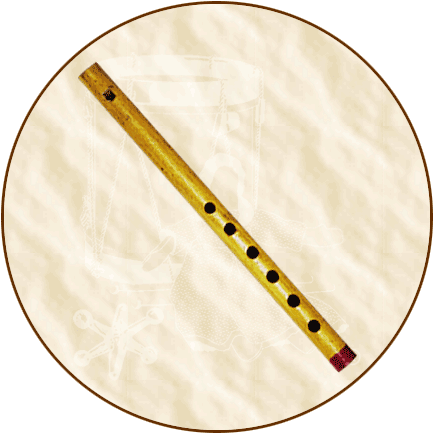.
Continued from product description on
Folk Instruments' Page One...
Historical
Background: The bamboo flute may well be one of man's
first multi-note wind instruments. Since it was made from bamboo,
only written records can help us trace its roots (no pun intended).
Obviously, the bamboo flute's true origin can be any ecological
region that has bamboo as part of its flora. And while early
accounts place it in India, China and Japan, bamboo grows in
many other areas. Therefore, it is reasonable to assume that
many ancient cultures could have developed some type of flute
made from a section of bamboo.
In India, this flute has been called many names. The prevailing
name is "bansuri," which is derived from the word for
bamboo or "banse." Other Hindu names are "algoza,"
"bansi," "kolalu," "kolavi," "kukhl,"
"murali," "nar," "pava," "pillankuzhal,"
"pillangrovi," "pulangoil," "vanu, and
"vamsi." These names further suggest that many ancient
Indian tribes independently invented bamboo flutes which became
part of their music cultures and, sometimes, even religious rituals.
The bamboo flute was generally used as a folk instrument to
accompany dancers (including semi-religious dances). The Hindu
deity Krishna is often depicted as a sheepherder playing a bamboo
flute. Over the centuries, the bamboo flute has earned itself
a prominent place in Indian music and mythology.
There is also an ancient Chinese wind instrument belonging
to the flute family called a "yeu." It was an important
instrument and used in many ancient Chinese ceremonial rituals.
By the way, "yeu" is pronounced the same as the word
"music" in Chinese. The yeu is the most frequently
mentioned wind instrument in the book "Shi Jing" (The
Book of Songs), an ancient collection of poetry compiled in the
6th century B.C.
About 1,700 years ago, the yeu disappeared following the Han
Dynasty (206 B.C.-220 A.D.). This is when two ancient bamboo
flutes became the dominant Chinese wind instruments. One was
the "dizi," which was played transversely; and the
other was the "xiao," which was played vertically.
Why the yeu disappeared and what it looked like remain a mystery.
Even during the Tang Dynasty (618-907 A.D.), little reference
is given to the yeu in either court or folk music.
In 1986 and 1987, a number of wind instruments were discovered
in central China's Henan Province. These artifacts survived because
they were not made from bamboo, but from animal bones. Nevertheless,
these instruments resembled the traditional bamboo flute and
could produce a complete seven-note scale. Chinese musicologists
later named these 8,000-year-old instruments "gudi,"
or "bone flutes." This archeological find pushed the
historical roots of Chinese music back another 3,000 years! Perhaps
bone flutes were man's first invented wind instrument. No one
knows! Eight-thousand-year-old bamboo flutes cannot be preserved
like 8,000-year-old bone flutes.
At the end of the 7th century, the bamboo flute was imported
to Japan from China. This flute was originally a six-hole flute
called a "gagaku-shakuhachi." Later on, though, a finger
hole was omitted to create a five-hole Japanese flute simply
called a "shakuhachi." Although little is known about
the music that was played on the shakuhachi during this period,
specimens have survived and are on display at Shoso-In in Nara,
Japan. These flutes are made from thin-walled bamboo and have
six finger holes.
Komuso monks (Priests of Nothing) would soon wander Japan
playing shakuhachis for money. These monks also regarded the
shakuhachi more as a spiritual aid rather than as a musical instrument.
They knew that the sounds produced by this flute could soothe
a person's body and soul (or mind). These monks practiced "suizen,"
or "blowing Zen," because it was more a spiritual experience
-- both for the performer and the listener -- than a musical
experience. For a shakuhachi player, the primary goal was to
"become a Buddha in one sound" (ichion jobutsu).
The result of this mindful playing was haunting and dramatic.
The music had free-flowing rhythms and compositional structure
(honkyoku). Each honkyoku performance differed no matter how
many times the same piece was played (perhaps hundreds of times!).
Honkyoku is still enjoyed today for its stress-reducing effects.
Between the 12th and 16th centuries, the shakuhachi was played
by different classes of people. This included mendicant monks,
Emperor Go-Komatsu, and the famous Rinzai Zen Master Ikkyo of
Daitoku-ji in northern Kyoto. The shakuhachi was later referred
to as the "hitoyogiri" to distinguish it from the longer,
heavier, and bigger bore flutes that mendicant monks developed.
Fun
Fact: The sect Watazumi Do (Way of the Watazumi or "dôkyoku")
was founded in 1950. Watazumi-sensei believe that playing a shakuhachi
(which they call Tool of the Way or "dôgu") to
be one of the paths of Tao. The musical pieces performed on it
are called Pieces of the Way, or "dôguku."













